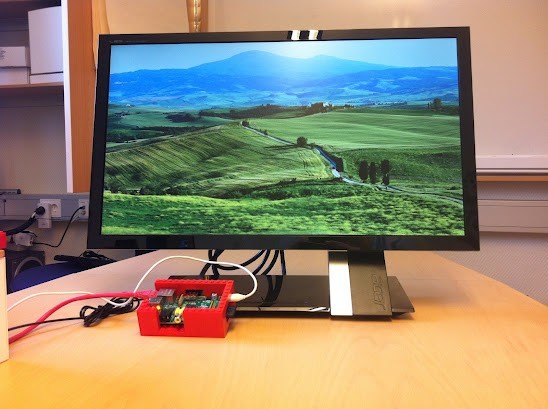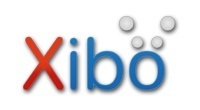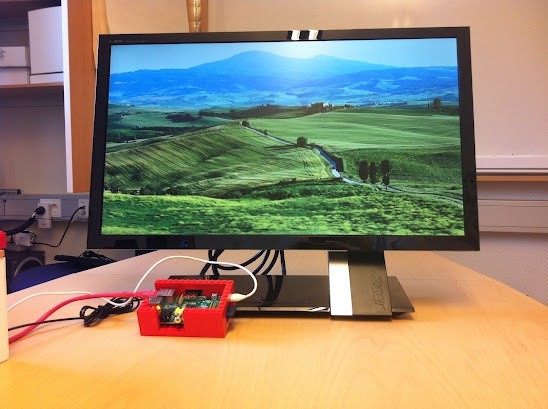
Roundup: As Expected, Lots Of Raspberry Pi In The Digital Signage Oven
July 27, 2012 by Dave Haynes
The little Raspberry Pi project that is trying to push out a useful computing for $35 has, as expected, attracted attention and activity from the digital signage sector – which is steadily pushed on lowering costs and minimizing footprints.
There is now a wiki running on eLinux.org tracking some of the open source and commercial activity underway to turn the units into working players, using either existing open source digital signage code like Xibo or newly developed software. The Raspberry Pi people also have a searchable forum.
 Xibo is an open source digital signage software platform that’s been around for quite a while and appears to be fairly mature, with active development and support. There are 6,000+ screens running off Xibo, according to the webiste.
Xibo is an open source digital signage software platform that’s been around for quite a while and appears to be fairly mature, with active development and support. There are 6,000+ screens running off Xibo, according to the webiste.
The work being tracked suggests it is early days, still, for the Pi device, but one geek set up a system that emulated the Pi’s set-up and ran Xibo successfully.
A UK company called JADS is developing something called Targetr and already has the Pi working with its application. But that first version is limited and wobbly:
TargetR can already be used on Raspberry Pi by starting a web browser and using the standard TargetR WebPlayer. However, as you may have experienced the Raspberry Pi struggles rendering HTML and scaling large images.
It’s not clear, but based on other JADS products it will be free as single licenses, but fee-based software for larger deployments and sold through partners.
It looks interesting because the idea is to have something that can deliver multimedia content to any device or web page, with full remote control and reporting. It’s certainly not even close to the first solution to be based on HTML pages, but it’s been optimized to work with devices that don’t have a lot of horsepower.
 The students at RPI (aka Rensselaer Polytechnic Institute) in Troy, NY – a highly regarded tech university – have been steadily developing another open source platform, Concerto, since 2008. The platform and support community looks very active.
The students at RPI (aka Rensselaer Polytechnic Institute) in Troy, NY – a highly regarded tech university – have been steadily developing another open source platform, Concerto, since 2008. The platform and support community looks very active.
This forum indicates there are people trying to make Concerto work on the Pi, but struggling because it is an ARM processor. Concerto runs on Linux but, I think from the website, needs a conventional x86-based computer to run.
Then there is something called Screenly (what is it with adding “ly” to digital companies?). That’s Screenly in the main photo at the top, the enclosure evidently made from Lego.
From the developers:
When we started Skarmverket, a small network of public billboards in Sweden, we evaluated many of the existing solutions on the market. Most of them were clunky and/or expensive. A fair number of them ran on Windows and used Adobe Flash. We ended up writing our own solution and used Asus Eee PCs with Linux.
Then the Raspberry Pi came along. Priced at $35, and equipped with everything needed to power a screen. We were immediatelly sold and knew that this was what we wanted to use moving forward. Since we love Open Source, we’ve decided to release Screenly for free for anyone to use.
The current version should be consider a beta. While we have been running it in the lab without any issues, there might still be issues that we are unaware of at this point. Yet, we wanted to make Screenly available to the vibrant Rasberry Pi community.
Since Screenly was written for the Raspberry Pi from the ground up, we had to make it as lean as possible.
There are many use cases where Screenly can be used, such as:
- Display BI or server dashboards
- Advertisements (in-store or in store-front)
- Internal information boards
- Fancy photo-frame
There is a video uploaded this week, which shows it takes a full two minutes to get the thing running and then it is just showing still images. So I would describe this as BETA in ALL CAPS.
Then you have the main technical guys at signagelive and Silver Curve also fiddling with unit, using the Ayuda OpenSplash media player.
Bill Gerba from Wirespring tells me his guys have done “full ports of FireCast Enterprise and EasyStart, though the web UI runs pretty slowly from that little chip, especially if it’s already busy showing content.”
A couple of take-aways from this.
First is a reminder that there are numerous open source projects out there for digital signage and they are not just hobbyist efforts that companies would be crazy to try out. A company, or more likely an academic institution riddled with propeller-heads, could possibly do quite well with this sort of thing.
The Raspberry Pi is very early stage still and just one option for low cost playback hardware. You will see mainstream commercial companies like signagelive with way more resources, experience and time actively looking at low-cost ARM-based (smartphone and tablet CPU) devices as an an alternative to x86 (regular PC) devices.
The group behind Raspberry Pi says it is now manufacturing 4,000 units a day.





Leave a comment